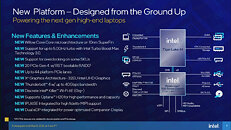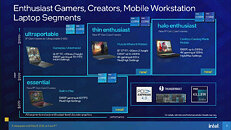- Joined
- Oct 9, 2007
- Messages
- 47,579 (7.46/day)
- Location
- Dublin, Ireland
| System Name | RBMK-1000 |
|---|---|
| Processor | AMD Ryzen 7 5700G |
| Motherboard | ASUS ROG Strix B450-E Gaming |
| Cooling | DeepCool Gammax L240 V2 |
| Memory | 2x 8GB G.Skill Sniper X |
| Video Card(s) | Palit GeForce RTX 2080 SUPER GameRock |
| Storage | Western Digital Black NVMe 512GB |
| Display(s) | BenQ 1440p 60 Hz 27-inch |
| Case | Corsair Carbide 100R |
| Audio Device(s) | ASUS SupremeFX S1220A |
| Power Supply | Cooler Master MWE Gold 650W |
| Mouse | ASUS ROG Strix Impact |
| Keyboard | Gamdias Hermes E2 |
| Software | Windows 11 Pro |
Intel's fabled 8-core "Tiger Lake-H" silicon built on the 10 nm SuperFin process, is close to reality. The company's upcoming 11th Gen Core "Tiger Lake-H" processors for performance- and gaming notebooks, leverages this die. An HD Tecnologia report leaks alleged company slides from Intel that detail the processor line up and feature-set. To begin with, the 11th Gen Core-H series processors come in core-counts ranging from 4-core/8-thread, to 6-core/12-thread, and 8-core/16-thread. Look at the embargo date on the leaked slides, one could expect a formal launch as close as May 11, 2021.
The 10 nm SuperFin "Tiger Lake-H" silicon features 8 "Willow Cove" CPU cores, and an updated iGPU based on the company's latest Gen12 Xe LP graphics architecture. Each of the eight CPU cores has 1.25 MB of L2 cache, and they share a massive 24 MB of L3 cache. The Gen12 Xe LP iGPU only has 32 execution units (EUs), according to the slides, 1/3rd those of the 96 EUs on the "Tiger Lake-U." The uncore component is also updated, now featuring dual-channel DDR4-3200 native support, and a 28-lane PCI-Express 4.0 root-complex. 16 of these lanes are wired out as PEG (PCI-Express Graphics), four as a CPU-attached NVMe slot, and eight toward the 8-lane DMI 3.0 chipset bus.



The lineup is led by the Core i9-11980HK, this generation's flagship SKU, designed for "halo" segment gaming laptops. This chip maxes out the "Tiger Lake-H" silicon, runs the 8 CPU cores at speeds of up to 5.00 GHz, and has a rated TDP of 65 W. It is also unlocked for overclocking. This part is followed by the i9-11900H, with the same hardware features, but lacking in overclocking features; boost frequency of up to 4.90 GHz, and TDP of 45 W. The Core i7-11800H has the same 8-core/16-thread core-count as the Core i9 parts, but with lower clock speeds of up to 4.60 GHz.

The Core i5 SKUs within this lineup are 6-core/12-thread, and come with 12 MB of shared L3 cache (as opposed to the expected 18 MB, if we were to go buy the logic of 3 MB L3$ slices per core on the silicon). The Core i5-11400H and i5-11260H boost at frequencies of up to 4.10 GHz and 4.00 GHz, respectively; and come with 35 W TDP. The already-launched Core i7-11370H presents an anomaly to this lineup. Based on the same 4-core/8-thread silicon as the "Tiger Lake-U" silicon, with its TDP bumped up to 28 W, this is a U-segment processor buffed up to be H-segment.

Intel in its presentation, trained its guns on AMD's Ryzen 9 5900HS processor to compare with its Core i5-11400H part. The company is banking heavily on the high IPC of its "Willow Cove" CPU cores to see its performance-price equation through against the "Zen 3" based Ryzen 5000H/HS series.
Besides the up to 20 PCIe Gen 4 lanes from the processor, the chipset puts out up to 24 PCI-Express Gen 3.0 downstream lanes. Platform I/O updates include support for Thunderbolt 4 (40 Gbps), and Wi-Fi 6E.
View at TechPowerUp Main Site
The 10 nm SuperFin "Tiger Lake-H" silicon features 8 "Willow Cove" CPU cores, and an updated iGPU based on the company's latest Gen12 Xe LP graphics architecture. Each of the eight CPU cores has 1.25 MB of L2 cache, and they share a massive 24 MB of L3 cache. The Gen12 Xe LP iGPU only has 32 execution units (EUs), according to the slides, 1/3rd those of the 96 EUs on the "Tiger Lake-U." The uncore component is also updated, now featuring dual-channel DDR4-3200 native support, and a 28-lane PCI-Express 4.0 root-complex. 16 of these lanes are wired out as PEG (PCI-Express Graphics), four as a CPU-attached NVMe slot, and eight toward the 8-lane DMI 3.0 chipset bus.



The lineup is led by the Core i9-11980HK, this generation's flagship SKU, designed for "halo" segment gaming laptops. This chip maxes out the "Tiger Lake-H" silicon, runs the 8 CPU cores at speeds of up to 5.00 GHz, and has a rated TDP of 65 W. It is also unlocked for overclocking. This part is followed by the i9-11900H, with the same hardware features, but lacking in overclocking features; boost frequency of up to 4.90 GHz, and TDP of 45 W. The Core i7-11800H has the same 8-core/16-thread core-count as the Core i9 parts, but with lower clock speeds of up to 4.60 GHz.

The Core i5 SKUs within this lineup are 6-core/12-thread, and come with 12 MB of shared L3 cache (as opposed to the expected 18 MB, if we were to go buy the logic of 3 MB L3$ slices per core on the silicon). The Core i5-11400H and i5-11260H boost at frequencies of up to 4.10 GHz and 4.00 GHz, respectively; and come with 35 W TDP. The already-launched Core i7-11370H presents an anomaly to this lineup. Based on the same 4-core/8-thread silicon as the "Tiger Lake-U" silicon, with its TDP bumped up to 28 W, this is a U-segment processor buffed up to be H-segment.

Intel in its presentation, trained its guns on AMD's Ryzen 9 5900HS processor to compare with its Core i5-11400H part. The company is banking heavily on the high IPC of its "Willow Cove" CPU cores to see its performance-price equation through against the "Zen 3" based Ryzen 5000H/HS series.
Besides the up to 20 PCIe Gen 4 lanes from the processor, the chipset puts out up to 24 PCI-Express Gen 3.0 downstream lanes. Platform I/O updates include support for Thunderbolt 4 (40 Gbps), and Wi-Fi 6E.
View at TechPowerUp Main Site





